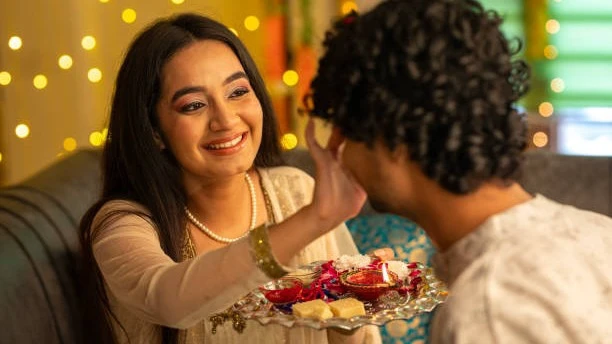As dawn breaks on a warm August morning, sisters across India prepare their thalis with trembling hands and joyful hearts-tiny lamps flicker beside threads of protection, love, and lifelong promises.
Raksha Bandhan isn’t just a ritual; it’s a feeling. A moment that wraps up shared childhoods, secret jokes, and unspoken support in one sacred thread.
In 2025, Raksha Bandhan falls on Saturday, August 9, and brings with it the perfect blend of tradition and togetherness. Whether you’re in the same city or continents apart, this day is about celebrating the emotional legacy of sibling bonds and doing it at the right time matters just as much as the sentiment.
Here’s everything you need to know from the shubh muhurat to why Bhadra time is to be avoided, and how this ancient festival continues to evolve with every generation.
RAKSHA BANDHAN TH CEREMONY TIMINGS
According to Drik Panchang, the most auspicious time for tying Rakhi (Thread Ceremony) in 2025 is
- Thread Ceremony Time: 05:47 am to 01:24 pm
- Duration: 7 hours and 37 minutes
- Purnima Tithi Begins at: 02:12 pm on August 8, 2025
- Purnima Tithi Ends: 01:24 pm on August 9, 2025
- Bhadra Ends: Before sunrise on 9 August
This means that the entire morning period on August 9 is auspicious, and rituals can be performed safely without concern for inauspicious timings.
IMPORTANCE OF TIMING: WHY BHADRA MUST BE AVOIDED
In Hinduism, Bhadra is considered an inauspicious time (especially during the first half of Purnima Tithi). Rituals performed during Bhadra are believed to bring negative outcomes. Religious scriptures like Vratraj explicitly advise against performing Rakhi rituals during this period.
In 2025, Bhadra ends before sunrise, which is ideal, ensuring that the entire thread-tying ceremony can be done during Shubh Muhurat.
WHY APARAHNA MUHURAT IS PREFERRED
Traditionally, Aparahna Kaal (late afternoon) is the most recommended period for performing the Rakhi ceremony. However, when Bhadra does not overlap with morning hours-as in 2025-the ceremony can safely begin from early morning.
In case Aparahna is not accessible, Pradosh Kaal (early evening) is the next best option. But for 2025, the morning time is not only permissible but highly auspicious.
THE RITUALS OF RAKSHA BANDHAN
Raksha Bandhan is marked by a simple yet emotionally significant set of rituals
- Sisters prepare a thali with a rakhi, sweets, diya, roli, and rice.
- Brothers receive the rakhi on their right wrist, get a tilak on the forehead, and offer a promise of protection in return.
- Gifts are exchanged, often followed by a shared meal or sweet.
- In many families, even bhabhis (sisters-in-law) receive a rakhi or lumba rakhi, extending the ritual to newer familial bonds.
CULTURAL AND SPIRITUAL SIGNIFICANCE
The legend behind Raksha Bandhan spans stories from mythology and history
- Krishna and Draupadi: When Krishna hurt his finger, Draupadi tore her saree to bandage him. He vowed to protect her.
- Rani Karnavati and Humayun: The queen of Mewar sent a rakhi to the Mughal emperor, asking for help.
- These tales highlight the protective, emotional, and unifying aspects of the festival, beyond just siblings.
RAKSHA BANDHAN TODAY: A BOND BEYOND BLOOD
In modern times, Rakhi is tied not only by sisters to brothers but also
To sisters, bhabhis, and cousins
Between friends and community members as a token of trust and protection
In schools, from children to jawans and police officers, to show respect
The festival continues to evolve while staying rooted in tradition.
- Date: Saturday, 9 August 2025
- Rakhi Thread Ceremony Time: 05:47 am – 01:24 pm
- Bhadra Ends: Before sunrise (safe for rituals)
- Best Muhurat: Aparahna (late afternoon), though morning is also auspicious in 2025
- Avoid: Bhadra Kaal, especially Bhadra Mukha
For a heartfelt and timely Raksha Bandhan celebration, aligning rituals with accurate Panchang timings ensures both tradition and spiritual harmony are honoured.
